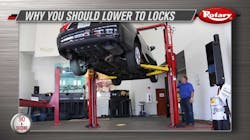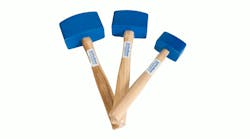Before starting work on a vehicle elevated by a lift, technicians should make sure the lift is on its mechanical locks. But this doesn’t always happen. And when it doesn’t, it can be a costly mistake.
“It’s hard to believe that this simple step is one of the most important and overlooked in the lifting process,” says Ron Lainhart, manager, Service Network Excellence for Rotary Lift. “Lowering the lift to the locks is not just a safety precaution, it also helps protect the lift from premature wear. Shop managers should share this short video with their staff to drive home the importance of always lowering lifts to their locks.”
The importance of lowering to locks is one reason Rotary introduced LockLight, a patent-pending lift accessory that shows technicians, shop managers and health/safety inspectors at a glance if a hydraulic vehicle lift is resting on its locks. When LockLight detects that the lift’s hydraulic pressure has been relieved, it illuminates a green light, indicating that the lift is on its locks and giving technicians a visual confirmation that it’s OK to begin work.
The American National Standard covering lift construction, testing and validation, ANSI/ALI ALCTV: 2017, requires all automotive lifts except screw drive systems to incorporate an automatically engaging mechanical load-holding device. Lowering the lift to its mechanical load-holding device/locks is a standard industry safety practice. By relieving the lift’s hydraulic pressure and placing the load securely on mechanical load-holding devices, the technician reduces the chance of the lift freefalling if the lifting system fails. In addition to protecting the technician, lowering to locks also protects the lift. Failure to lower lifts to their locks results in increased strain on the lift’s hydraulic cylinder and other lifting components, which could cause the lift to jump or chatter at restart and could decrease the life span of the lifting system.


